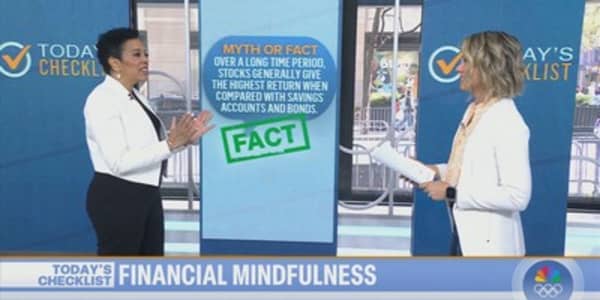Banks are eager to lend a hand to first-time homebuyers, but that doesn't mean you should borrow as much as they'll loan you. Why? It's all about the cash flow.
Older millennials in their early 30s are looking to buy homes. The median age of a first-time buyer is about 33, up from 29 in the 1970s, according to Zillow, a real estate marketplace site.
Lenders have recently introduced programs that will make it easier for creditworthy borrowers to buy a home with very little down even as they juggle other demands, like student loan repayment or starting a family.
Banks have partnered with Fannie Mae and Freddie Mac, two entities that provide financing to lenders, to make mortgages available to first-time buyers with a down payment that's as low as 3 percent. For instance, Wells Fargo launched "yourFirstMortgage" in late May. Similar programs are available at SunTrust and Bank of America. Quicken Loans offers a mortgage with a down payment option of just 1 percent.
The demand is there, banking industry representatives say. Fifteen percent of single-family home loans made in 2015 were to first-time buyers, according to the American Bankers Association. That figure has risen most years since 2009, when 9 percent of loans were made to new home purchasers.
At the same time, the median listing price for a home in the U.S. is $239,900, up 4.8 percent year over year, according to Zillow.
The low down-payment programs are different from past initiatives to encourage home ownership: Borrowers need to prove they have sufficient income and strong credit profiles, and banks generally are using fixed-rate mortgages instead of adjustable-rate loans.
"The documentation and verification is very different," said David Doyle, lending product and pricing executive at Bank of America, which also runs a first-time buyer program. "The minimum credit score is 660," he said. "It goes back to the point of demonstrating credit history and behaviors that indicate stability."
"If there is anything the crisis should have underscored for industry participants, it's that not all products are correct for all borrowers," Doyle said.
Planners warn that while these first-time homeowner programs are helpful, borrowers should not overlook the true measure of home affordability: monthly cash flow.
Cash flow is king
Your debt-to-income ratio is the key metric to determine the amount you can safely borrow.
Housing costs, including principal and interest payments on your mortgage, as well as taxes and insurance, should account for no more than 28 percent of your gross monthly income. This so-called "front-end ratio" is a rule of thumb among lenders and financial planners.
Meanwhile, the monthly payment for your total debt, including credit cards and student loans, should not exceed 36 percent of your gross monthly income. This figure is known as the "back-end ratio."
If your monthly debt payments equal as much as 43 percent of your gross monthly income, a lender may provide you with a "qualified mortgage," a loan that doesn't have harmful features, such as "interest only" payment periods or loan terms that are beyond 30 years.
Some banks are willing to offer mortgages to first-time borrowers who fall into that category — and, in some cases, whose debt repayments exceed 43 percent of their gross income.
Some advisors worry this high debt level may be unsustainable for borrowers.
"Putting down 3 percent is terrific in a low interest rate environment," said Adam Kozak, a certified financial planner at KPL Financial Group in Eastchester, New York. "But how does that affect your cash flow? Can you eat?"
To keep things conservative, Kozak recommends that prospective borrowers use no more than 20 percent of their net monthly income toward servicing consumer debt, including credit cards and student loans.
Earmark 10 percent of your gross income for retirement, as well, and be sure that you have enough money for adequate life and disability insurance, Kozak said. Prospective buyers should also ensure they have enough of an emergency reserve to cover three to six months' worth of expenses.
"Cash flow is always top of mind, just like if you were a company," he said. Below, Kozak provides an example of a couple who are balancing manageable levels of debt and sufficient cash flow.
Mr. and Mrs. Smith live within their means
Gross annual income: $140,000
Federal income tax bracket: 25%
Net income, excluding FICA: $105,000
Acceptable housing costs at 28% of gross income: $39,200 annually or $3,267 per month
Acceptable consumer debt at 8% of net income: $8,400 annually or $700 per month
Total debt payment is 34% of gross income: $47,600 or $3,967 per month
The Smiths can still save 10% of their gross income and use the remainder for living expenses.
Unexpected costs
Another reason why monthly cash flows affect how much you can safely borrow: costs likely go up when you're a homeowner.
"Typically, when you're moving from an apartment to a house, you're getting more space — that means higher utility bills," said Eric Roberge, a certified financial planner and founder of Beyond Your Hammock in Boston.
Those who opt to make small down payments will also need to account for the monthly cost of private mortgage insurance, which normally kicks in when borrowers put down less than 20 percent. Bank of America's program doesn't require this coverage. Others do.
In general, mortgage insurance can be as high as 1.5 percent of the amount originally borrowed each year.
Finally, don't forget how a new baby down the road might impact your cash flows. Fifty-four percent of the nearly 900 families polled by Care.com said they spent more than 10 percent of their household income on child care.
"People need to look ahead and not commit to big housing costs," said Kristin C. Sullivan, a certified financial planner with Sullivan Financial Planning in Denver. "There may be things down the pike."






